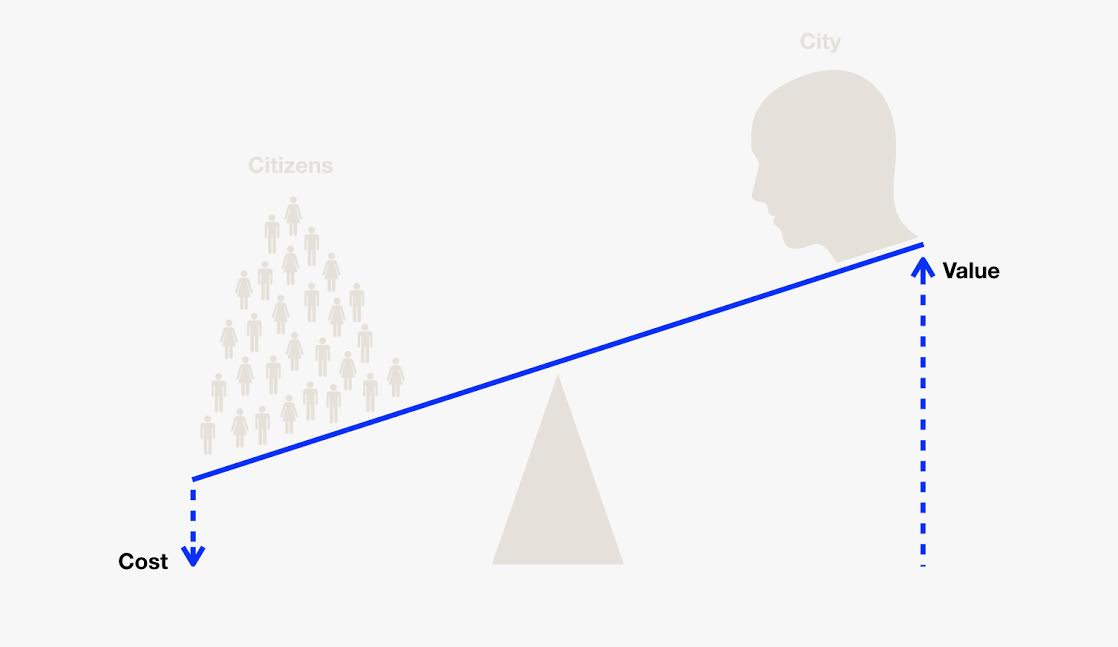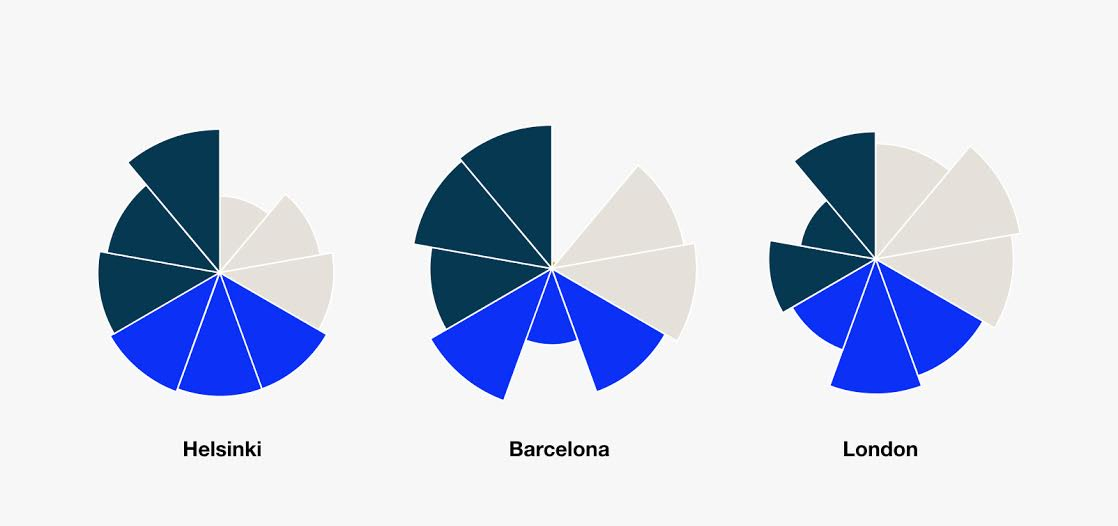-
-
-
-
URL copied!
This blog was originally posted by GlobalLogic’s experience design arm, Method.

Who Pays?
Cities are the original sharing economy — a sharing ecosystem in practice founded on a cost-orientated logic where services and infrastructure are collectively funded through taxes and fees. Participants, whether individuals or organizations, contribute relative to their means, leaving the collective whole better off than their individual contribution. Utilitarianism in action, with all the soft benefits adding a general sense of belonging, pride of place, and a perch on the world’s stage.
According to the UN, there are 1,692 cities with a population of 300,000 or more people. If we designed a new city from scratch today, with all levels of participants in mind (citizens, companies, government entities), would we operate in the same “business model?” What if there’s a mission greater than simply cost sharing and provision of services? What if today’s mindset, methodologies, and capabilities help us organize value for an exponentially higher purpose and collective benefit? What if the economy of a city was centered around value creation rather than basic cost sharing?
These questions aren’t merely a theoretical exercise — in reality they’re the potential new model for the future that forward leaning cities are already walking into and adapting. It’s a journey we are actively shaping in our Strategic Design work with city administrations and infrastructure providers through emergent models and mindsets for growth and innovation, such as the EVRY Strategic Design Lab.
Why Now?
In cities large and small, a common set of pressure points are bearing down ever more intensively. Disposable income, industry footprints, tax bases, corporate investment, and shipped innovation are in decline. Meanwhile, population, cost of services, income inequality, and social isolation are on the rise. Consequently, the revenue required for provision of services isn’t adding up by traditional measures. Sanitation collection frequency diminishes, parks go unattended, classrooms close, and community services shut down. Each setback acting as a standalone line-item of the economy, counting pennies to balance budgets. The resulting culture of cuts comes at the greater expense of growth and opportunity.
In this landscape, how can a city shift its approach from service provision, rule enforcement, and taxation to one of opportunity and value creation? In other words, how can a city actively evolve from being viewed as a simple balance sheet to an enabler of multiple interconnected forces that harness the holistic power of its cultural and economic potential?
Who Creates Value?

Cities are places of opportunity. The long-term global urbanisation growth demonstrates the mobility of people to greater possibilities. Cities necessarily thrive and decline based on the opportunities (or lack thereof) created by each generation.
Today, we see a shift in mindset from the city as a single economy to one of multiple inter-connected economies forced on the next generation of opportunity, thereby orientating each participant towards the holistic value and impact created with other forces in their own and adjacent economies. By thinking of cities as a holistic platform, structured around the intertwined economies and contributing forces, we can tap the full potential and spectrum of opportunities through the five economies of a City of Opportunity:
1. Education Economy
2. Logistics Economy
3. Cultural Economy
4. Knowledge Economy
5. Environmental Economy
Within an economy-centric model, the creation and growth of value is inherently collaborative for citizens, organizations, and governmental agencies. Most importantly, it allows cities to think about roles for citizens, not only for the city itself but also in one or more of its economies. As citizens of an economy, they gain a sense of place that goes beyond the physicality of a neighborhood or one’s favorite sports team, and orientate around the value they generate.
By approaching the business model of a city as a meta-mode economy, each of these interlinked economies can work towards a greater vision with a clear sense of purpose. Every city has its own unique make up, born from its distinctive geographic, historic, culture, and human composition from which to draft a vision. A vision that captures a civic aspiration that holistically and collaboratively creates value for its many contributors.
We go beyond campaign slogans, logos, and five year plans, to a North Star that allows inclusive collaboration in a participant’s economy. Collaboration that enables participants to adapt and grow in stride with emergent local and world events more quickly and relevantly than any central administration could.
How is Value Captured?

Whether as individuals, organizations, or the government, we each have a role in making our cities thrive. While the value creation moment is important, so to is value capture: in line with the goals defined in our city’s vision.
A true City of Opportunity is a portfolio of small, medium, and large participants collaborating and contributing their unique capabilities to civic life. Through clarity of vision and visibility towards long-term outcomes within their economy, autonomous participants create and collaborate to contribute their unique value to the city. The economy-centric model allows them to see their role and realize its full holistic potential. Every city will have its own vision, transforming the role of a town hall beyond just operating the services of today, to create the value of tomorrow.
As a city goes from being the funder/benefactor of yesterday’s policies to being the facilitator of the platform of economies for tomorrow’s opportunities, a town hall can do what a large government does best: use its scale to create opportunity for the many, openly and inclusively. The intent of scale is not to control centrally, but to facilitate collectively, with the aim of establishing a positive outcomes-oriented vision. A vision that’s openly and objectively tracked through high-level quantitative and qualitative indicators — a balanced scorecard of the economy, weighed by financial, environmental, and social progress.
At a company level, we’ve seen the functional impact on society cities can make: step-change improvements in development with a contemporary digital mindset founded on user value, continuous improvements, and holistic outcomes. And as cities are as much emotional as functional, we need a more complete, representative, and balanced way of holistically thinking about the model of where we live.
Who is Leading the Way?
In our research and work with progressive cities and government agencies, we see the emergence of a new generation of urban leaders. Such leaders are growing their impact born from the logic of citizen-centric models and their resulting value creation. This new mindset enables leaders to break free from the traditional struggles of simultaneously optimizing their current model while trying to envision and implement emergent opportunities for each city. Optimistically, we see real momentum, pragmatic progress, and a new muscle growing for how we design the operational model of cities.
Here are some leaders we admire and learn from. Please share your favorites.
Snippet: Who is Leading the Way?:
Vancouver on Environmental Economy,
Paris for the Knowledge Economy
Helsinki the Logistics Economy.
Peru for the Education Economy
Estonia for e-citizenship creating a wider economy of actors.
Top Insights
Best practices for selecting a software engineering partner
SecurityDigital TransformationDevOpsCloudMediaMy Intro to the Amazing Partnership Between the...
Experience DesignPerspectiveCommunicationsMediaTechnologyAdaptive and Intuitive Design: Disrupting Sports Broadcasting
Experience DesignSecurityMobilityDigital TransformationCloudBig Data & AnalyticsMedia
Let’s Work Together
Related Content
Share this page:
-
-
-
-
URL copied!